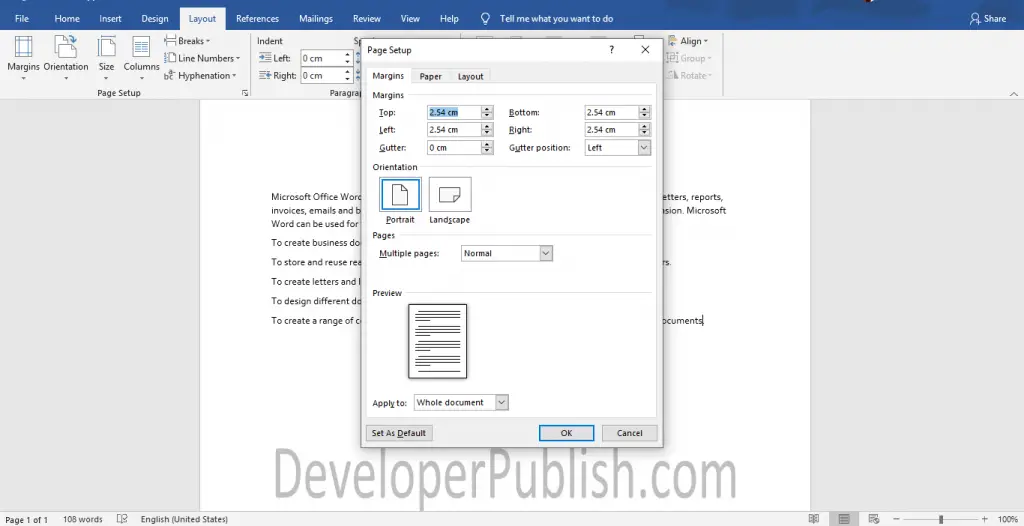
- #CHANGE MARGIN FOR ONE PARAGRAPH PDFKIT HOW TO#
- #CHANGE MARGIN FOR ONE PARAGRAPH PDFKIT PDF#
- #CHANGE MARGIN FOR ONE PARAGRAPH PDFKIT INSTALL#
- #CHANGE MARGIN FOR ONE PARAGRAPH PDFKIT CODE#
- #CHANGE MARGIN FOR ONE PARAGRAPH PDFKIT DOWNLOAD#
# import PageBreak, along with SimpleDocTemplateįrom atypus import SimpleDocTemplate, PageBreak Report.drawString(50, 800, "**This is the third page.**")Īnother way to create page breaks using the SimpleDocTemplate from earlier in the post is like this: Report.drawString(50, 800, "**This is the second page.**") Report.drawString(50, 800, "**This is the first page.**") Report = canvas.Canvas("multiple_pages.pdf") Then, we can call the showPage method again to create a third page. Any content you create afterward will be added to the next page. One way to tell ReportLab the content on a single page is finished is to use the showPage method, like below.
#CHANGE MARGIN FOR ONE PARAGRAPH PDFKIT PDF#
To handle creating multiple pages, we’ll modify the above example to create a PDF with three separate pages. This is a common and useful task to be able to do.
#CHANGE MARGIN FOR ONE PARAGRAPH PDFKIT HOW TO#
Next, let’s show how to create a PDF with multiple pages. Report.drawString(50, 800, "**Test PDF with Different Font**") Report = canvas.Canvas("test_with_font.pdf") To adjust font types, we can tweak our first ReportLab example above to use the setFont method.
#CHANGE MARGIN FOR ONE PARAGRAPH PDFKIT CODE#
Generalizing on our code above, we can add a few paragraphs of text, followed by a sample image. # create Image object with size specifications This provides more structure than using canvas, like above.įrom atypus import SimpleDocTemplateĭoc = SimpleDocTemplate("sample_image.pdf") For this instance, the list will contain just one element – the Image object represeting the image that we will put into the PDF file, but as we’ll see in the next example, we can also use this list to store other elements for placing into the PDF file.Īlso, note here we are using the SimpleDocTemplate class, which basically does what it sounds like – creates a simple document template that we can use to fill in information. In this example, we need to create a list of elements that we will use to construct the PDF file (we refer to this list as info below). Here, we’re going to use the pillow library to create an Image object. Next, let’s create a sample PDF file containing an image. Report.drawString(50, 800, "**First PDF with ReportLab**") The (50, 800) are coordinates for where to place the text (this might take some experimentation). Third, we use drawString to write out a line of text.
Then, we create an instance of the Canvas (note the capital “C” this time) class with the name of the file we want to create. The first piece of code imports the canvas module from ReportLab.

Here’s an initial example to create a simple PDF with one line of text. ReportLab is one of the most popular libaries for creating PDF files. The next package we’ll discuss is ReportLab. om_string(table_html, output_path = "sample_table.pdf", configuration = config)Ĭreating PDF files with Python and ReportLab Let’s do another example, but this time, we’ll create a table using HTML and CSS. You simply need to pass the HTML as a string or store it in a file that can be passed to pdfkit. You can also create PDF files with more complex HTML / CSS, as well. om_file("sample_html_file.html", output_path = "new_file2.pdf", configuration = config) om_string(s, output_path = "new_file.pdf", configuration = config)Īdditionally, pdfkit can create PDF files by reading HTML files. One of the nicest features of pdfkit is that you can use it to create PDF files from HTML, including from HTML strings that you pass it directly in Python. om_url("", output_path = False, configuration = config) You can also set the output path to False, which will return a binary version of the PDF into Python, rather than downloading the webpage to an external file. om_url("", "sample_url_pdf.pdf", configuration = config)
#CHANGE MARGIN FOR ONE PARAGRAPH PDFKIT DOWNLOAD#
# download Wikipedia main page as a PDF file # configure pdfkit to point to our installation of wkhtmltopdfĬonfig = nfiguration(wkhtmltopdf = r"C:\Program Files\wkhtmltopdf\bin\wkhtmltopdf.exe") To get pdfkit working, you’ll need to either add wkhtmltopdf to your PATH, or configure pdfkit to point to where the executable is stored (the latter option is used below). In the example below, we download Wikipedia’s main page as a PDF file. Once you’re set up, you can start using pdfkit.
#CHANGE MARGIN FOR ONE PARAGRAPH PDFKIT INSTALL#
To get started, you’ll need to install it along with a utility called wkhtmltopdf.

A nice feature of pdfkit is that you can use it to create PDF files from URLs. Pdfkit was the first library I learned for creating PDF files. This post will cover two packages used to create PDF files with Python, including pdfkit and ReportLab. In a previous article we talked about several ways to read PDF files with Python.


 0 kommentar(er)
0 kommentar(er)
